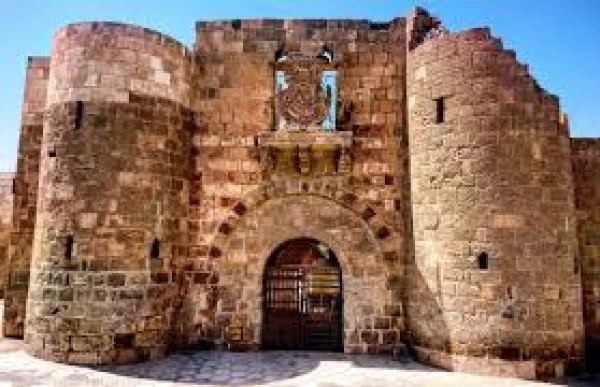
Aqaba Fortress
Aqaba Castle is an ancient castle located in the center of the city of Aqaba in southern Jordan, specifically on the shore of the Gulf of Aqaba. This castle dates back to the end of the Mamluk era in the region, but today it has been turned into a museum.
The Aqaba Fortress is also known as Mamluk Castle. It offers a glimpse into the rich history of Aqaba as every corner of the castle recites a tale about its magnificence and grandeur. In earlier times it served as a pilgrimage stop, but now it’s a popular tourist site.
The castle has a quadrilateral shape, and on each corner, there is a stone tower, and these towers have now been destroyed. 1501-1516), the phrase was written: “He ordered the construction of this blessed and happy castle, our Master the Sultan, the Ashraf King Abu Al-Nasr Qansuh Al-Ghouri, the Sultan of Islam and the Muslims,” and “Our Master, Sultan Al-Ashraf King Murad bin Salim Khan, may his victory, renew this castle.”
One of the highlights of the castle is the Aqaba mast. It was built in 2004 in the square adjacent to the castle to carry the flag of the Great Arab Revolt. At that time, the mast was the tallest in the world.
The castle was originally built as a Crusader castle, and it was largely rebuilt by the Mamluks in the fourteenth century, specifically in 1587 AD during the reign of the last Mamluk sultan, and it changed several times after that. By the beginning of the sixteenth century, Aqaba fell under the control of Ottoman rule. The city declined and remained a small and insignificant fishing village for about 400 years. During World War I in 1917, the Ottoman forces withdrew from the city after the Arab army of Sharif Hussein bin Ali, leader of the Great Arab Revolt with the help of Lawrence of Arabia, attacked them. It became one of the main strongholds of the revolt against the Turks. The fortress was under Egyptian authority until the year 1892 when it was handed over to the Ottoman Empire until the Great Arab Revolt began, and the Jordanian tribes took it as a headquarters and a starting point for liberating the Levant from the Ottoman rule that lasted 400 years.
Latest Articles
Admin
Seabourn Sojourn Cruise Stops in Safaga Port
The Seabourn Sojourn, the flagship vessel of Seabourn Cruise Line's ultra-luxury fleet, was built in 2008 at the T. Mariotti shipyard in Genoa, Italy. Measuring 198 metres, it can accommodate up to 450 guests in its 225 spacious all-suite staterooms.
Admin
Norwegian Sky Cruise Stops in Safaga Port
Norwegian Cruise Line operates a cruise ship called the Norwegian Sky. It was constructed in 1999 and can accommodate 2,004 passengers in addition to 878 crew members. The ship has several dining establishments, lounges and bars, a spa and fitness center, swimming pools, and a number of entertainment areas.
Admin
Explora II Cruise Stops in Safaga Port
Explora II, the second vessel in the Explora Journeys fleet, sets sail in 2024 to redefine luxury cruising. With 461 ocean-front suites, 9 culinary experiences, and 4 pools, this haven of sophistication and sustainability promises an unforgettable "Ocean State of Mind" journey to inspiring destinations.
Admin
Mein Schiff 6 Cruise Stops in Safaga Port
The Mein Schiff 6 is the latest cruise ship in the renowned TUI Cruises fleet, offering passengers a luxurious and sophisticated cruise experience. At 315 metres long, this floating resort features a range of dining options, entertainment, and recreational facilities, including a spa, fitness centre, and sports amenities.
Admin
Mein Schiff 4 Cruise Stops in Safaga Port
When the Mein Schiff 4 cruise ship docks in Safaga, Egypt, passengers are granted access to a realm of ancient wonders. Aboard this state-of-the-art vessel, guests can embark on meticulously curated shore excursions that showcase the region's most iconic landmarks, including the Giza Pyramids, the enigmatic Sphinx, and the remarkable tombs and temples of the Valley of the Kings in Luxor.
Admin
MS Europa Cruise Stops in Safaga Port
The Silver Moon, Silversea's latest flagship, is a luxury cruise ship that offers an exceptional travel experience for Venezuelans exploring Egypt. With a capacity of 596 guests and an impressive 40,700 gross tonnes, the Silver Moon maintains the small-ship intimacy and spacious all-suite accommodations that are the hallmarks of the Silversea brand.













